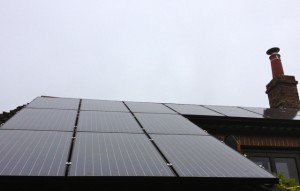12 months ago today two engineers drove away from our house after fitting 13 solar panels to our roof, and connecting the system to the National Grid. Their parting words were: “You’re now generating your own power”.
True, although only up to a point. That many panels goes nowhere near providing the energy to run an entire house, particularly one like ours, originally built in the 1830s.
But we have real reasons to feel more than merely virtuous by making a contribution, if ever so tiny, to slowing climate change.
Self-interest comes into it. The 2.47 kWh array cost us £7,862. We came in on the then generous Feed In Tariff (FIT) of 43.3p per kilowatt hour we generate.
In the 12 months I’ve been keeping a rough monthly tally ((I haven’t yet explored whether we can take a reading direct from our computers) of the kilowatt-hours generated. I kept a closer eye during those extended periods of sunny weather back in the spring when the meter did seem to advance at an impressive rate. Compare that with this particular dull week in October, when it’s been inching forward like a comatose snail.
First illuminating point to make is that the original estimates of what we would generate were uncannily accurat. One was 1970.072 kW. That was based on the governments Standard Assessment Procedure for energy rating buildings (SAP2009).
The second estimate was based on something called PVSol Expert 4.5, and it produced an annual total kilowatt hours estimate of 1898 kW.
Sorry to labour you with figures, but both were remarkably accurate. The actual reading I took this morning was 1964 (technically I should take the reading tomorrow, which is the actual anniversary). I should point out that we had a brief period this month when what the system was generating wasn’t being measured, because a switch tripped in the meter box, so those figures above are lower than they might have been.
This is what it has done for the planet. Averaging the figures above, we saved 1023 kilograms of CO2. (I should add that our roof is not in the most favorably inclined position, facing south-west.)
And this is what it’s done for us. We’ve made, averaging the figures in those two separate projections, because our final payments haven’t yet arrived, the handsome sum of £1100. That takes into account “generation tariff”, “export tariff” and “saving on electricity regenerated”.
As the estimates seem to be so accurate, we’re well on target to pay back our investment in the anticipated time of 7.6 years.
Did we take the right decision? I have no doubt about it. The panels have needed no maintenance, although I have neglected to wash them – cold water and a long brush – yet. The engineer recommended twice a year. And that improves efficiency, so we might have generated even more power.
The only problem we had was that switch trip, which meant the meter wasn’t taking any readings at all for some days, although I suspect no more than a week. But we could easily have missed that and it would have cost us money, particularly in the peak generating time in the summer. (The panels and the inverter are both guaranteed for 10 years.)
Since October 2011, the Feed In Tariff has fallen to a level which is far less generous to the consumer. From November 2012 the government pays 15.44 p per kWh of energy generated by a house’s panels.
But the cost of solar panels has fallen too, by an estimated 65% over the past 18 months or so. The solar industry said panels still represent an attractive finanical investment of around 10 per cent annually, but admitted its message that installation costs were falling was failing to get through to consumers. It says a 4kW system has dropped in cost from around £9,000 in April 2012 to £7,500 in September 2012.
I did a quick check, filling in my post code, on the Energy Saving Trust Trust and found that we would have an income about half of that September 2011 estimate, if we bought that same size system today.
The Eco Experts (Solar comparison website) maintain that this is the time to go solar, with energy bills spiralling: “On balance with the promise of a substantial profit and savings on existing electricity bills there is little doubt solar panels are indeed a good investment for most homeowners.”
I’m so baffled when I pass houses being built (October 2012) by major builders without a single panel on their roofs. Surely the additional cost, factored into the cost of building the house, with the cost of panels falling all the time, must be very low. Are none of the big builders willing to take a chance on this?
I am guaranteed the 43.3 feedback tariff on my solar panels for another 24 years. This seems an awfully long time. I suspect that before our system has paid for itself, in another 6.5 years, there will be more efficient solar panels on the market, and 20 years from now we will have already replaced the panels with something we can’t even conceive of.
Or am I being too idealistic? I still have nagging doubts that those climate change sceptics, if not outright deniers, will still slow things down sufficiently that by 2030 we could still be generating most of our energy from coal-fired power stations.

